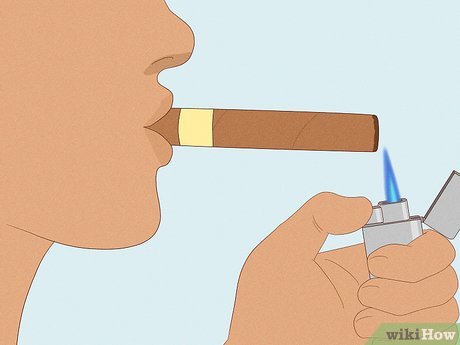“How to smoke a cigar” is more than burning tobacco. It is a sensory experience defined by aroma, texture, craftsmanship, and etiquette. Understanding how to smoke a cigar properly ensures balanced flavor, steady burn, and respect for the ritual built by generations of cigar makers and connoisseurs.
This guide explains every step in detail from choosing your cigar to lighting, smoking, pairing, and etiquette so that even a beginner can experience it like a seasoned aficionado.
What Is a Cigar and Why Technique Matters
A cigar is a tightly rolled bundle of fermented and aged tobacco leaves made for slow smoking. It differs from cigarettes in construction, composition, and purpose.
A properly smoked cigar is savored, not inhaled. The smoke is drawn into the mouth to appreciate the layered flavors created by the fermentation and blending process.
The method of smoking matters because technique influences temperature, flavor stability, draw resistance, and aroma. Poor handling can destroy the experience or cause an uneven burn.
Understanding Cigar Anatomy
| Component | Function | Description |
|---|---|---|
| Wrapper | Outer Leaf | Determines 60%–70% of flavor and aroma. Thin, oily, smooth leaf. |
| Binder | Middle Layer | Holds filler together. Adds strength and burn consistency. |
| Filler | Core Tobacco | Combination of long or short leaves defining body and complexity. |
| Cap | Sealed End | Prevents unraveling; must be cut before smoking. |
| Foot | Open End | The part you light. |
Knowing these components helps you identify where to cut, how to light, and what to expect in flavor transitions.
Step 1: Choose the Right Cigar
Selecting the proper cigar is the foundation of the experience.
1. Check Construction Quality
Inspect the wrapper under natural light. It should appear smooth, with no cracks or soft spots. Roll the cigar gently between your fingers; it should feel evenly firm from head to foot.
2. Determine Strength and Body
-
Mild cigars – Connecticut Shade, Ecuadorian Connecticut; ideal for beginners.
-
Medium cigars – Habano or Corojo wrappers; balanced flavor and spice.
-
Full-bodied cigars – Maduro or Oscuro wrappers; deeper aroma, heavier nicotine profile.
3. Choose Size According to Time
-
Petite Corona / Robusto (30–45 min) – Compact, even burn.
-
Toro / Churchill (60–90 min) – Standard for relaxation sessions.
-
Double Corona / Presidente (90–120 min) – Extended, event-length smoke.
Time and tolerance decide your choice. Longer cigars offer layered flavor transitions, while shorter ones suit beginners or short breaks.
Step 2: Prepare Your Accessories
Professional smokers always prepare their tools beforehand.
Essential Accessories List:
-
Sharp cigar cutter (guillotine, punch, or V-cut).
-
Butane lighter or long cedar matches.
-
Cigar ashtray with wide rest.
-
Humidor or travel case for storage.
-
Hygrometer to monitor humidity (around 68–72%).
Clean accessories maintain purity. Never use petrol lighters; they leave a chemical aftertaste.
Step 3: Cut the Cap Correctly
Locate the Shoulder
Every premium cigar has a rounded head sealed by the cap. The “shoulder” marks where the curve starts. Cut only the tip above this line — roughly 1/8 inch.
Choose a Cutting Method
-
Straight Cut – Creates an open draw; preferred for most shapes.
-
V-Cut – Produces a concentrated draw, enhancing flavor density.
-
Punch Cut – Best for smaller ring gauges; neat circular hole.
Quick Tip: Use one confident motion. A slow or dull cut can crush the wrapper and ruin airflow.
Step 4: Toast the Foot Before Lighting
To toast means warming the cigar’s foot before taking your first puff.
Hold the cigar at a 45° angle, about an inch above the flame. Rotate it slowly. The edges should darken evenly before lighting.
This pre-heat removes moisture, caramelizes oils, and ensures a uniform burn.
Step 5: Light the Cigar Properly
Once toasted, place the cigar between your lips. Keep the flame just below the foot without touching it. Draw gently while rotating until an orange glow forms across the edge.
Important Facts
-
The flame should kiss the cigar, not engulf it.
-
A full, even cherry indicates a perfect light.
-
Blow softly on the foot to confirm uniform glow.
If one side burns faster, touch up lightly with your lighter.
Step 6: Smoke with Proper Technique
Draw, Don’t Inhale
Cigar smoke is meant for taste, not the lungs. Pull the smoke into your mouth, swirl it gently to absorb the complex flavors, then exhale.
Control the Cadence
Puff every 30–45 seconds. Over-puffing overheats the cigar, turning the taste bitter. Slow puffing cools the ember and enhances aroma.
Rotate Regularly
Rotate the cigar after every few puffs. It maintains an even burn and prevents canoeing (one-sided burn).
Step 7: Manage Ash Like a Pro
Allow ash to build about one inch before gently rolling it off into the tray. A strong ash shows good construction, but letting it fall naturally avoids breakage.
Never flick or crush ash. Simply rest the cigar on the ashtray edge, let the ash fall with light motion, and continue your smoke.
Step 8: Relight When Necessary
Cigars can extinguish during conversation or rest. Relighting is normal.
Relighting Process
-
Remove leftover ash.
-
Re-toast the foot until it glows.
-
Draw gently while rotating.
Never relight over unremoved ash; it traps stale smoke and alters flavor.
Step 9: Taste, Pair, and Appreciate
Cigars unfold flavors in thirds — the first, middle, and final stage. Each third exposes different tobacco oils and blends.
Common Flavor Profiles
-
First Third: Light spices, cedar, coffee notes.
-
Middle Third: Sweet wood, cocoa, toasted nuts.
-
Final Third: Earth, leather, black pepper.
Pairing heightens the flavor contrast.
Popular Pairings List:
-
Mild cigar + light rum, white wine, or coffee.
-
Medium cigar + bourbon, porter beer, or aged tequila.
-
Full-bodied cigar + dark rum, single-malt Scotch, espresso.
Step 10: Follow Cigar Etiquette
Cigar smoking carries social conventions rooted in respect and refinement.
Basic Etiquette Rules
-
Light your own cigar; do not share flames directly.
-
Avoid inhaling or blowing smoke toward others.
-
Wait until the cigar warms before removing the band.
-
Never stub out a cigar; let it rest and extinguish naturally.
-
Ask before lighting indoors or near others.
Social Setting Awareness
In lounges or events, observe the atmosphere. Maintain quiet conversation. Compliment another smoker’s choice rather than criticize. Offer your cutter if requested, but never force advice.
Step 11: Know When to End the Cigar
The final third carries stronger nicotine and concentrated oils. When the flavor becomes hot or harsh, rest the cigar on the tray and let it go out naturally. Crushing it releases unpleasant odor.
Dispose of the remains once cooled. Wash hands and face if you wish to neutralize scent.
Step 12: Store Cigars Correctly
Cigars are living tobacco products that continue to age after rolling. Improper storage dries them out or causes mold.
Ideal Conditions
-
Humidity: 68–72%
-
Temperature: 18–21 °C (65–70 °F)
-
Storage: Spanish cedar humidor lined with hygrometer.
Rotate cigars inside the humidor monthly for consistent moisture.
Step 13: Troubleshooting Common Issues
| Issue | Cause | Solution |
|---|---|---|
| Uneven Burn | Wind, fast puffing | Rotate or touch up with lighter |
| Tight Draw | Overpacked filler | Massage gently, recut tip |
| Bitter Taste | Overheating | Slow puffing, purge smoke |
| Cigar Went Out | Long pause | Knock off ash, re-toast foot |
| Wrapper Cracking | Dry storage | Re-humidify in humidor |
Cigar smoking is precision and patience. Every small correction preserves the intended flavor.
Step 14: Safety and Health Considerations
While cigars are not inhaled, nicotine and tar still enter the body through oral mucosa. Moderation is essential. Always smoke in well-ventilated areas and maintain good oral hygiene afterward.
Step 15: Advanced Appreciation: Retrohaling and Tasting Notes
Retrohaling is the process of gently exhaling a small amount of smoke through the nose. This activates the olfactory receptors, revealing deeper notes such as cocoa, cinnamon, or roasted nuts. It should be done carefully and sparingly to avoid irritation.
Flavor Journaling: Many enthusiasts keep a cigar diary. Record brand, size, strength, tasting notes, and burn behavior. Over time, this builds personal expertise and brand preference.
Step 16: The Cultural Significance of Cigars
Cigars symbolize celebration, reflection, and luxury. Historically, leaders like Winston Churchill and Ernest Hemingway were known for their cigars. The ritual represents patience, craftsmanship, and appreciation of tradition.
Countries such as Cuba, the Dominican Republic, Nicaragua, and Honduras dominate production, each region imparting distinct soil minerals and curing styles. Learning regional characteristics refines one’s palate.
Top Beginner Cigars
| Brand | Origin | Wrapper | Body | Flavor Notes |
|---|---|---|---|---|
| Montecristo White Series | Dominican Republic | Ecuadorian Connecticut | Mild | Cream, cedar, almond |
| Romeo y Julieta Reserva Real | Nicaragua | Ecuador Connecticut | Medium | Toasted nuts, light spice |
| Padron 2000 Maduro | Nicaragua | Maduro | Full | Cocoa, espresso, leather |
| Arturo Fuente Hemingway Short Story | Dominican Republic | Cameroon | Medium | Sweet wood, nuts |
| Oliva Serie G | Nicaragua | African Cameroon | Medium | Chocolate, coffee |
Frequently Asked Questions
1. Should I inhale cigar smoke?
No. Cigar smoke is meant to be tasted, not inhaled. Inhaling can cause dizziness and nausea.
2. How long does a cigar last?
A small Robusto lasts 30–45 minutes; larger Churchill cigars may exceed 90 minutes depending on puff frequency.
3. Can I relight a half-smoked cigar later?
Yes. Remove the ash, store in a sealed bag, and relight within 24 hours. Expect a stronger, smokier flavor.
4. What causes an uneven burn?
Wind exposure, rapid puffing, or poor construction. Correct by rotating or gently toasting the slower-burning side.
5. Why does my cigar taste bitter?
Overheating or puffing too frequently caramelizes the sugars and releases tar. Allow cooling intervals between draws.
6. How do I store cigars without a humidor?
Use an airtight plastic box with a damp sponge or humidity pack. Maintain 65–70 °F and check weekly.
7. What beverage best complements a cigar?
Dark spirits like rum, whiskey, and cognac pair best. Non-alcoholic pairings include espresso or sparkling water to cleanse the palate.
8. Is removing the cigar band necessary?
Optional. Many keep it on for style; others remove after a few minutes when the heat loosens the glue to avoid tearing the wrapper.
9. How far should I smoke a cigar?
Stop when flavor turns harsh or heat uncomfortable—typically two inches from the end.
10. How can I tell a quality cigar?
Consistent firmness, smooth wrapper, even aroma, and balanced resistance on the cold draw indicate craftsmanship.
See More: Does Ketamine Therapy Get You High? A Clinical, Clear, and Complete Guide
Why Does Pure Water Dehydrate You? Myths, Truths, and Science Explained
Conclusion
Smoking a cigar correctly transforms a simple act into an art form. It merges patience, sensory awareness, and etiquette. When you understand how to cut, light, and savor properly, you experience the tobacco’s full potential from the delicate sweetness of the wrapper to the deep resonance of aged filler leaves. Respecting the craft means more than smoking; it means participating in a tradition that values craftsmanship, calmness, and taste. Whether you light up occasionally or collect fine cigars worldwide, these principles ensure every draw delivers pure satisfaction.

